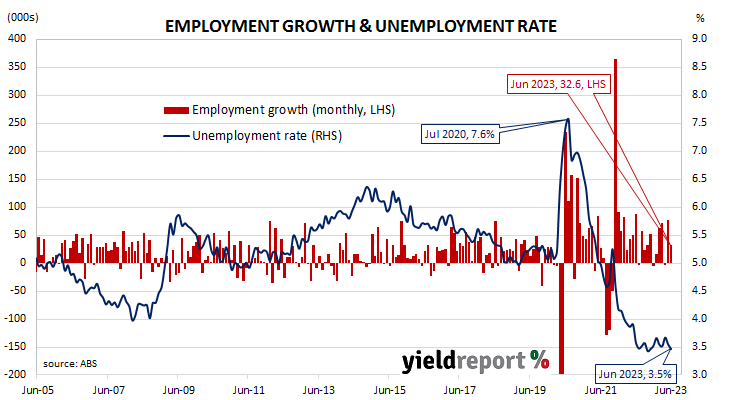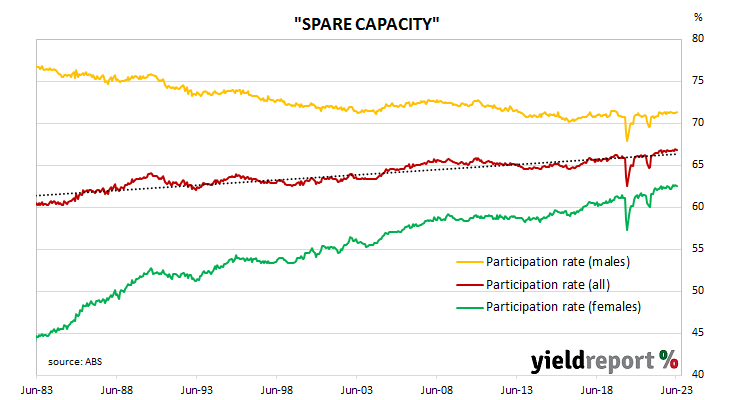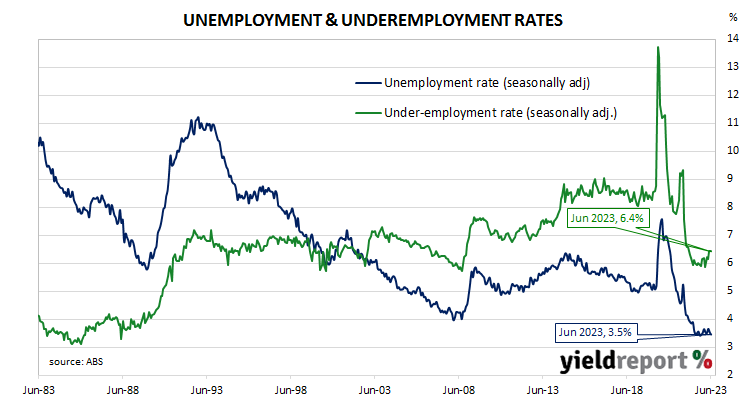Summary: Employment up 32,600 in June, more than expected; ANZ: robust jobs growth possibly bolstered by rapid population growth; participation rate slips to 66.8%; jobless rate steady at 3.5%; fewer part-time, more full-time jobs; aggregate work hours up 0.3%; underemployment rate steady at 6.4%.
Australia’s period of falling unemployment came to an end in early 2019 when the jobless rate hit a low of 4.9%. It then averaged around 5.2% through to March 2020, bouncing around in a range from 5.1% to 5.3%. Leading indicators such as ANZ-Indeed’s Job Ads survey and NAB’s capacity utilisation estimate suggested the unemployment rate would rise in the June 2020 quarter and it did so, sharply. The jobless rate peaked in July 2020 but fell below 7% a month later and then trended lower through 2021 and 2022.
The latest Labour force figures have now been released and they indicate the number of people employed in Australia according to ABS definitions increased by 32,600 in June. The result was more than the 15,000 increase which had been generally expected but is considerably less than May’s 76,600 rise after revisions.
“While headline jobs growth looks robust, that needs to be considered against the backdrop of the current very rapid pace of population growth,” said ANZ Head of Australian Economics Adam Boyton.
Domestic Treasury bond yields increased noticeably on the day, ignoring overnight movements of US Treasury yields. By the close of business, the 3-year ACGB yield had gained 12bps to 3.90%, the 10-year yield had added 9bps to 3.95% while the 20-year yield finished 5bps higher at 4.20%.
In the cash futures market, expectations regarding further rate rises hardened. At the end of the day, contracts implied the cash rate would rise from the current rate of 4.07% to average 4.205% in August and then to 4.275% in September. February 2024 contracts implied a 4.465% average cash rate while May 2024 contracts implied 4.435%, 36bps more than the current rate.
“The slowdown in economic activity suggests employment growth and growth in hours work should cool materially over coming months,” added Boyton. He pointed to several leading labour market indicators which “point to a drift higher in the unemployment rate over coming months.”
The participation rate slipped from May’s figure of 66.9% to 66.8% as the total available workforce increased by 21,700 to 14.551 million while the number of unemployed persons decreased by 1,600 to 504,400. As a result, the unemployment rate remained steady at 3.5% after revisions and rounding.
The aggregate number of hours worked across the Australian economy increased by 0.3% as 6,800 residents lost part-time positions and 39,300 residents gained full-time positions. On a 12-month basis and after revisions, aggregate hours worked increased by 4.7% as 30,200 more people held part-time positions and 379,600 more people held full-time positions than in June 2022.
More attention has been paid to the underemployment rate in recent years, which is the number of people in work but who wish to work more hours than they do currently. June’s underemployment rate remained unchanged at 6.4%, 0.6 percentage points above this cycle’s low.
The underutilisation rate, that is the sum of the underemployment rate and the unemployment rate, has a strong correlation with the annual growth rate of the ABS private sector wage index when advanced by two quarters. June’s underutilisation rate of 9.9% corresponds with an annual growth rate of about 4.3%.




